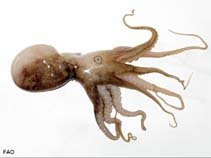Amphioctopus membranaceus (Quoy & Gaimard, 1832)
Webfoot octopus
Classification / Names Common names | Synonyms | CoL | ITIS | WoRMS
Cephalopoda | Octopoda | Octopodidae | Octopodinae
Environment: milieu / climate zone / depth range / distribution range Ecology
Benthic; depth range ? - 60 m (Ref. 275). Tropical; 41°N - 22°S, 45°E - 142°W (Ref. 275)
Distribution Countries | FAO areas | Ecosystems | Occurrences | Introductions
Indo-Pacific: from Indian Ocean to Japan and Australia.
Length at first maturity / Size / Weight / Age
Maturity: Lm 22.5, range 20 - ? cm Max length : 30.0 cm TL male/unsexed; (Ref. 275); max. published weight: 500.00 g (Ref. 275)
Life cycle and mating behavior Maturity | Reproduction | Spawning | Eggs | Fecundity | Larvae
Main reference
References | Coordinator | Collaborators
Roper, C.F.E., M.J. Sweeney and C.E. Nauen 1984 FAO Species Catalogue. Vol. 3. Cephalopods of the world. An annotated and illustrated catalogue of species of interest to fisheries. FAO Fish. Synop. 125(3):277p. Rome: FAO. (Ref. 275)
IUCN Red List Status
(Ref. 130435: Version 2025-1)
CITES status (Ref. 108899)
CMS (Ref. 116361)
Threat to humans
Human uses
Fisheries: commercial
| FishSource |
Tools
More information
Max. ages / sizes
Length-weight rel.
Length-length rel.
Length-frequencies
Mass conversion
Abundance
Internet sources
BHL | BOLD Systems | CISTI | DiscoverLife | FAO(Publication : search) | Fishipedia | GenBank (genome, nucleotide) | GloBI | Gomexsi | Google Books | Google Scholar | Google | PubMed | Tree of Life | Wikipedia (Go, Search) | Zoological Record



